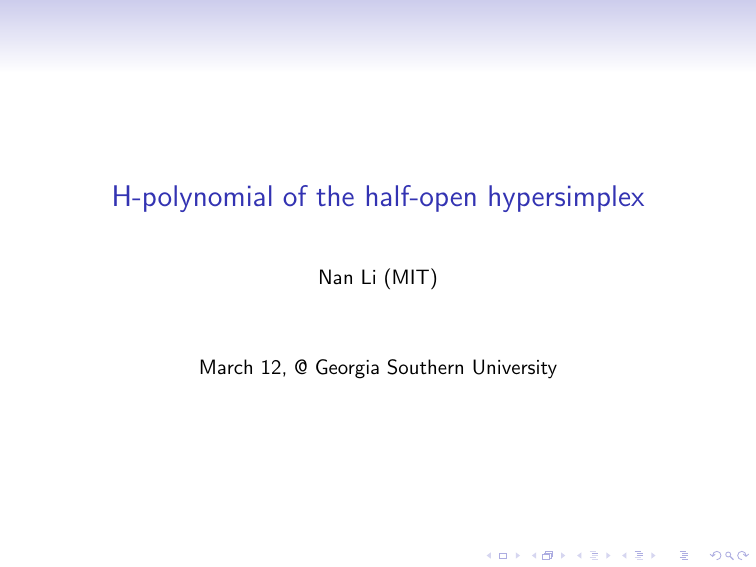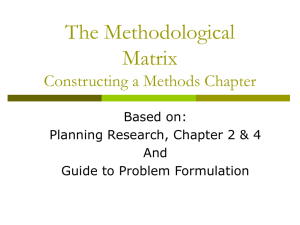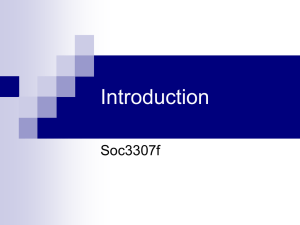H-polynomial of the half-open hypersimplex Nan Li (MIT)
advertisement

H-polynomial of the half-open hypersimplex
Nan Li (MIT)
March 12, @ Georgia Southern University
Outline
• Definitions and background
• Main theorem
• Proof: by a shellable triangulation
Hypersimplex
• For 0 < k < n, the (k, n)-th hypersimplex is defined as
∆k,n = {(x1 , . . . , xn ) ∈ [0, 1]n | x1 + · · · + xn = k}.
• Equivalently, project it to the first n − 1 coordinates:
∆k,n = {(x1 , . . . , xn−1 ) ∈ [0, 1]n−1 | k − 1 ≤ x1 + · · · + xn−1 ≤ k}.
For example: ∆k,3 and ∆k,4 .
??
??
??
??∆2,3
??
∆1,3 ???
?
}2? 2
}} 22? ?
}
2
}
? 3,4
2LL∆
?N}?}
LL?L
?N? N
??0_ _ _ _L?
???0 ∆2,4
??0 ∆1,4 For a permutation w ∈ Sn , we call i ∈ [n − 1] a descent of w , if
w (i) > w (i + 1). We define des(w ) to be the number of descents of w .
For example, 1, 3 are descents of 3241.
Theorem (Laplace)
The normalized volume of ∆k,n is the Eulerian number Ak,n−1 , i.e., the
number of permutations in Sn−1 with des(w ) = k − 1.
Hypersimplex
• For 0 < k < n, the (k, n)-th hypersimplex is defined as
∆k,n = {(x1 , . . . , xn ) ∈ [0, 1]n | x1 + · · · + xn = k}.
• Equivalently, project it to the first n − 1 coordinates:
∆k,n = {(x1 , . . . , xn−1 ) ∈ [0, 1]n−1 | k − 1 ≤ x1 + · · · + xn−1 ≤ k}.
For example: ∆k,3 and ∆k,4 .
??
??
??
??∆2,3
??
∆1,3 ???
?
}2? 2
}} 22? ?
}
2
}
? 3,4
2LL∆
?N}?}
LL?L
?N? N
??0_ _ _ _L?
???0 ∆2,4
??0 ∆1,4 For a permutation w ∈ Sn , we call i ∈ [n − 1] a descent of w , if
w (i) > w (i + 1). We define des(w ) to be the number of descents of w .
For example, 1, 3 are descents of 3241.
Theorem (Laplace)
The normalized volume of ∆k,n is the Eulerian number Ak,n−1 , i.e., the
number of permutations in Sn−1 with des(w ) = k − 1.
Hypersimplex
• For 0 < k < n, the (k, n)-th hypersimplex is defined as
∆k,n = {(x1 , . . . , xn ) ∈ [0, 1]n | x1 + · · · + xn = k}.
• Equivalently, project it to the first n − 1 coordinates:
∆k,n = {(x1 , . . . , xn−1 ) ∈ [0, 1]n−1 | k − 1 ≤ x1 + · · · + xn−1 ≤ k}.
For example: ∆k,3 and ∆k,4 .
??
??
??
??∆2,3
??
∆1,3 ???
?
}2? 2
}} 22? ?
}
2
}
? 3,4
2LL∆
?N}?}
LL?L
?N? N
??0_ _ _ _L?
???0 ∆2,4
??0 ∆1,4 For a permutation w ∈ Sn , we call i ∈ [n − 1] a descent of w , if
w (i) > w (i + 1). We define des(w ) to be the number of descents of w .
For example, 1, 3 are descents of 3241.
Theorem (Laplace)
The normalized volume of ∆k,n is the Eulerian number Ak,n−1 , i.e., the
number of permutations in Sn−1 with des(w ) = k − 1.
Hypersimplex
• For 0 < k < n, the (k, n)-th hypersimplex is defined as
∆k,n = {(x1 , . . . , xn ) ∈ [0, 1]n | x1 + · · · + xn = k}.
• Equivalently, project it to the first n − 1 coordinates:
∆k,n = {(x1 , . . . , xn−1 ) ∈ [0, 1]n−1 | k − 1 ≤ x1 + · · · + xn−1 ≤ k}.
For example: ∆k,3 and ∆k,4 .
??
??
??
??∆2,3
??
∆1,3 ???
?
}2? 2
}} 22? ?
}
2
}
? 3,4
2LL∆
?N}?}
LL?L
?N? N
??0_ _ _ _L?
???0 ∆2,4
??0 ∆1,4 For a permutation w ∈ Sn , we call i ∈ [n − 1] a descent of w , if
w (i) > w (i + 1). We define des(w ) to be the number of descents of w .
For example, 1, 3 are descents of 3241.
Theorem (Laplace)
The normalized volume of ∆k,n is the Eulerian number Ak,n−1 , i.e., the
number of permutations in Sn−1 with des(w ) = k − 1.
Triangulations of ∆k,n
Stanley gave a geometric proof by a bijection between the simplices in a
triangulation Γ of ∆k,n and the set S = {w ∈ Sn−1 | des(w ) = k − 1}.
We can present the triangulation by a graph with vertex set S and we
connect two vertices if the simplices are adjacent (share a facet) in Γ.
Example
132
213
231
312
∆2,4
w ∈ S3 , des w = 1
3214
4
444
TT
??? 2143
jj4213
4312
1432
DD
D oo3142OO zzz
3241
2431
#
4132K ###
KK #
s
ss
4231
3421
∆3,5 : #{w ∈ S4 | des w = 2} = 11.
Theorem (T.Lam and A.Postnikov, 2005)
Stanley’s triangulation, Sturmfels’ triangulation, the alcove triangulation,
and the circuit triangulation of the hypersimplex are identical.
Triangulations of ∆k,n
Stanley gave a geometric proof by a bijection between the simplices in a
triangulation Γ of ∆k,n and the set S = {w ∈ Sn−1 | des(w ) = k − 1}.
We can present the triangulation by a graph with vertex set S and we
connect two vertices if the simplices are adjacent (share a facet) in Γ.
Example
132
213
231
312
∆2,4
w ∈ S3 , des w = 1
3214
4
444
TT
??? 2143
jj4213
4312
1432
DD
D oo3142OO zzz
3241
2431
#
4132K ###
KK #
s
ss
4231
3421
∆3,5 : #{w ∈ S4 | des w = 2} = 11.
Theorem (T.Lam and A.Postnikov, 2005)
Stanley’s triangulation, Sturmfels’ triangulation, the alcove triangulation,
and the circuit triangulation of the hypersimplex are identical.
Triangulations of ∆k,n
Stanley gave a geometric proof by a bijection between the simplices in a
triangulation Γ of ∆k,n and the set S = {w ∈ Sn−1 | des(w ) = k − 1}.
We can present the triangulation by a graph with vertex set S and we
connect two vertices if the simplices are adjacent (share a facet) in Γ.
Example
132
213
231
312
∆2,4
w ∈ S3 , des w = 1
3214
4
444
TT
??? 2143
jj4213
4312
1432
DD
D oo3142OO zzz
3241
2431
#
4132K ###
KK #
s
ss
4231
3421
∆3,5 : #{w ∈ S4 | des w = 2} = 11.
Theorem (T.Lam and A.Postnikov, 2005)
Stanley’s triangulation, Sturmfels’ triangulation, the alcove triangulation,
and the circuit triangulation of the hypersimplex are identical.
Triangulations of ∆k,n
Stanley gave a geometric proof by a bijection between the simplices in a
triangulation Γ of ∆k,n and the set S = {w ∈ Sn−1 | des(w ) = k − 1}.
We can present the triangulation by a graph with vertex set S and we
connect two vertices if the simplices are adjacent (share a facet) in Γ.
Example
132
213
231
312
∆2,4
w ∈ S3 , des w = 1
3214
4
444
TT
??? 2143
jj4213
4312
1432
DD
D oo3142OO zzz
3241
2431
#
4132K ###
KK #
s
ss
4231
3421
∆3,5 : #{w ∈ S4 | des w = 2} = 11.
Theorem (T.Lam and A.Postnikov, 2005)
Stanley’s triangulation, Sturmfels’ triangulation, the alcove triangulation,
and the circuit triangulation of the hypersimplex are identical.
Ehrhart polynomial and h-polynomial
Let P ⊂ RN be an n-dimensional polytope with integral vertices. For
example,
◦
(0, r )◦
◦
(0, 1) ◦
r ∈ P, #(r P ∩ Z2 ) = (r + 1)2
rP
P
◦
◦
◦
◦
(0, 0) (1, 0)
(0, 0)
(r , 0)
Theorem (Ehrhart)
i(P, r ) = #(rP ∩ ZN ), considered as a function of r , is a polynomial. We
call it the Ehrhart polynomial of P. Equivalently, its generating
function is rational and has the form
X
r ≥0
i(P, r )t r =
h(t)
,
(1 − t)n+1
where h(t) is a polynomial in t with degree ≤ n. We call h(t) the
h-polynomial of P, and the vector (c0 , . . . , cn ) the h-vector of P, where
ci is the coefficient of t i in h(t).
Ehrhart polynomial and h-polynomial
Let P ⊂ RN be an n-dimensional polytope with integral vertices. For
example,
◦
(0, r )◦
◦
(0, 1) ◦
r ∈ P, #(r P ∩ Z2 ) = (r + 1)2
rP
P
◦
◦
◦
◦
(0, 0) (1, 0)
(0, 0)
(r , 0)
Theorem (Ehrhart)
i(P, r ) = #(rP ∩ ZN ), considered as a function of r , is a polynomial. We
call it the Ehrhart polynomial of P. Equivalently, its generating
function is rational and has the form
X
r ≥0
i(P, r )t r =
h(t)
,
(1 − t)n+1
where h(t) is a polynomial in t with degree ≤ n. We call h(t) the
h-polynomial of P, and the vector (c0 , . . . , cn ) the h-vector of P, where
ci is the coefficient of t i in h(t).
Ehrhart polynomial and h-polynomial
Let P ⊂ RN be an n-dimensional polytope with integral vertices. For
example,
◦
(0, r )◦
◦
(0, 1) ◦
r ∈ P, #(r P ∩ Z2 ) = (r + 1)2
rP
P
◦
◦
◦
◦
(0, 0) (1, 0)
(0, 0)
(r , 0)
Theorem (Ehrhart)
i(P, r ) = #(rP ∩ ZN ), considered as a function of r , is a polynomial. We
call it the Ehrhart polynomial of P. Equivalently, its generating
function is rational and has the form
X
r ≥0
i(P, r )t r =
h(t)
,
(1 − t)n+1
where h(t) is a polynomial in t with degree ≤ n. We call h(t) the
h-polynomial of P, and the vector (c0 , . . . , cn ) the h-vector of P, where
ci is the coefficient of t i in h(t).
H-polynomial and half-open hypersimplices
Question
It
known that ci ∈ N and
Pis
n
i =0 ci = (n − 1)!vol(∆k,n ) = Ak,n−1 = #{w ∈ Sn−1 | des(w ) = k − 1}.
It is natural to ask for a combinatorial interpretation of the ci ’s.
Recently, Stanley gave a conjecture of what the ci count, for the
following half-open hypersimplices.
Definition
The half-open hypersimplex ∆′k,n is defined as: ∆′1,n = ∆1,n and if
k > 1, ∆′k,n = {(x1 , . . . , xn−1 ) ∈ [0, 1]n−1 | k − 1 < x1 + · · · + xn−1 ≤ k}.
• The volume formula and triangulations for ∆k,n also work for ∆′k,n .
• The ∆′k,n ’s form a disjoint union of the hypercube.
• We can compute h-polynomial of ∆k,n inductively from ∆′k,n .
H-polynomial and half-open hypersimplices
Question
It
known that ci ∈ N and
Pis
n
i =0 ci = (n − 1)!vol(∆k,n ) = Ak,n−1 = #{w ∈ Sn−1 | des(w ) = k − 1}.
It is natural to ask for a combinatorial interpretation of the ci ’s.
Recently, Stanley gave a conjecture of what the ci count, for the
following half-open hypersimplices.
Definition
The half-open hypersimplex ∆′k,n is defined as: ∆′1,n = ∆1,n and if
k > 1, ∆′k,n = {(x1 , . . . , xn−1 ) ∈ [0, 1]n−1 | k − 1 < x1 + · · · + xn−1 ≤ k}.
• The volume formula and triangulations for ∆k,n also work for ∆′k,n .
• The ∆′k,n ’s form a disjoint union of the hypercube.
• We can compute h-polynomial of ∆k,n inductively from ∆′k,n .
Main result
For a permutation w , we call i an excedance of w if w (i) > i. We
define exc(w ) to be the number of excedances of w .
Theorem (h-polynomial of the half-open hypersimplex)
X
r ≥0
i(∆′k,n , r )t r = (1 − t)−n
X
w∈ Sn−1
exc(w)=k−1
t des(w)
.
We have two proofs:
1. By a generating function method, based on the following formula of
Foata and Han, about the joint distribution of excedances and descents:
X X
n≥0 σ∈Sn
t des(σ) s exc(σ)
X
un
1−s
=
tr
.
n+1
(1 − t)
(1 − u)r +1 (1 − us)−r − s(1 − u)
2. By a shellable triangulation.
r ≥0
Main result
For a permutation w , we call i an excedance of w if w (i) > i. We
define exc(w ) to be the number of excedances of w .
Theorem (h-polynomial of the half-open hypersimplex)
X
r ≥0
i(∆′k,n , r )t r = (1 − t)−n
X
w∈ Sn−1
exc(w)=k−1
t des(w)
.
We have two proofs:
1. By a generating function method, based on the following formula of
Foata and Han, about the joint distribution of excedances and descents:
X X
n≥0 σ∈Sn
t des(σ) s exc(σ)
X
un
1−s
=
tr
.
n+1
(1 − t)
(1 − u)r +1 (1 − us)−r − s(1 − u)
2. By a shellable triangulation.
r ≥0
Shellable triangulation
Let Γ be a triangulation of an n-dimensional polytope P, and α1 , . . . , αs
be the simplices (maximal faces) of Γ.
• We call (α1 , . . . , αs ) a shelling of Γ, if for each 2 ≤ i ≤ s,
αi ∩ (α1 ∪ · · · ∪ αi −1 ) is a union of facets ((n − 1)-dimensional
faces) of αi .
• In this case, the number of facets in this intersection is called the
shelling number of αi (denoted by #(αi )).
Example
RR
Q QRRR
o qoqq
Q RQRα
Ro3 Mqoqqq
α4 m mooOOO Mα2
m omoooo α1 OOOMOOOM
oo
OOO
OOO α4 ooooo
O
o
α2 oOooOoOoOO α1
o
oo α3 OOOOO
ooo
Γ1 : Yes
Γ2 : No
In Γ1 above, we have #(α1 ) = 0, #(α2 ) = 1, #(α3 ) = 1 and #(α4 ) = 2.
Two results needed for the proof
We call a triangulation of a convex polytope unimodular if every simplex
in the triangulation has normalized volume one. For example, Stanley’s
triangulation for ∆k,n is unimodular.
Theorem (Stanley, 1980)
If an n-dimensional integral polytope P has a shellable unimodular
triangulation Γ, then
X
X
i(P, r )t r = (
t #(α) )(1 − t)−(n+1) .
r ≥0
α∈ Γ
Theorem
The number of permutations u ∈ Sn with k excedances equals the
number of permutations in Sn with k descents.
Two results needed for the proof
We call a triangulation of a convex polytope unimodular if every simplex
in the triangulation has normalized volume one. For example, Stanley’s
triangulation for ∆k,n is unimodular.
Theorem (Stanley, 1980)
If an n-dimensional integral polytope P has a shellable unimodular
triangulation Γ, then
X
X
i(P, r )t r = (
t #(α) )(1 − t)−(n+1) .
r ≥0
α∈ Γ
Theorem
The number of permutations u ∈ Sn with k excedances equals the
number of permutations in Sn with k descents.
Second proof: by a shellable triangulation
Recall that we want to prove that
X
r ≥0
i(∆′k,n , r )t r =
X
w∈ Sn−1
exc(w)=k−1
−n
t des(w)
(1 − t) .
Suppose that Γ is a shellable triangulation of ∆′k,n , then
X
r ≥0
i(∆′k,n , r )t r = (
X
t #(α) )(1 − t)−n .
α∈ Γ
Comparing the above two numerators (h-polynomials), we need to:
• assign α ∈ Γ a permutation wα ∈ Sn−1 with exc(w ) = k − 1.
• place a shelling order on Γ, and
• show that #(α) = des(wα ), for each α ∈ Γ.
Example: ∆′3,5
Recall that we have the following graph for Stanley’s triangulation for
∆3,5 :
3214
4
444
44
4213
2143
TTTT
jjjj ????
4312
1432
DD
z
DD
D ooo3142OOO zzzz
3241
2431
##
#
4132KK ##
KKK #
sssss
4231
3421
∆3,5
The vertices are {w ∈ S4 | des(w ) = 2}, where the underlined positions
are descents.
Example: ∆′3,5
By the equal distribution of excedances and descents, we change the
vertices of the graph to the following:
2̇
3̇14
4
444
44
??
2̇14̇3TTTT
jjjj2̇4̇31
??
3̇24̇1DD
1z3̇4̇2
DD
D ooo3̇4̇12OOO zzzz
4̇3̇12
3̇14̇2
##
#
4̇3̇21KKK ##
KK #
sssss
3̇4̇21
2̇4̇13
∆3,5
The vertices are {w ∈ S4 | exc(w ) = 2}, where the dotted positions are
excedances.
Example: ∆′3,5
Slightly changes will give us the graph for the half-open hypersimplex
∆′3,5 :
2̇
3̇14
4
444
44
??
2̇14̇3TTTT
jjjj2̇4̇31
??
3̇24̇1DD
1z3̇4̇2
DD
D ooo3̇4̇12OOO zzzz
3̇14̇2
## j* j*
4t 4t 4̇3̇12
#
4̇3̇21KKK ##
KK #
sssss
1q 1q 3̇4̇21
2̇4̇13 m- m∆′3,5
The waved edges from outside attached to a simplex α indicates that α
is adjacent to some simplex β in ∆2,5 , and the common facet α ∩ β is
removed from α.
Example ∆′3,5
We claim that there exists an ordering of the edges with the following
properties satisfied:
2̇
3̇14
Z44
444
4
?
_
? 4̇3̇iTTTT
2
4̇
3̇1
21
j
??
ujjj
?
3̇24̇1aDD
1z= 3̇4̇2
DD
D wooo3̇4̇12gOOO zzzz
3̇14̇2
Q## j j* j*
4t 4t 4̇4 3̇12
#
sss4̇9 3̇21eKKKK ###
K
ss
1q 1q 3̇1 4̇21
24̇13̇m m- m• the above directed graph is acyclic;
• any linear extension of the above order gives a shelling order;
• for each simplex α, #(α) = des(wα ), where wα is the permutation
assigned to it.
Acknowledgements
1. I thank my advisor Richard Stanley for introducing me to the
conjecture and giving me help and encouragement.
2. I thank Ira Gessel for helpful communication about the generating
function proof.
3. I thank Yan Zhang for a nice idea about an important lemma in the
shellable triangulation proof.
4. I thank Benjamin Iriarte, Joel Lewis, Alejandro Morales and Steven
Sam for their help with my talk.




